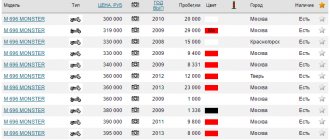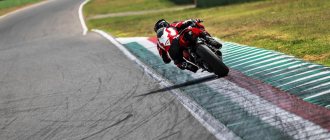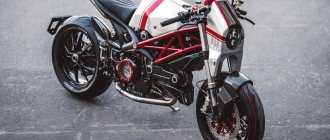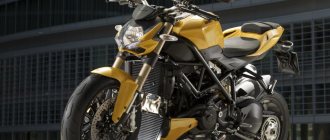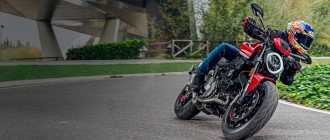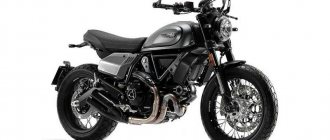Symptoms of an engine repair on a Ducati Monster 800 are:
- Extraneous noise in the engine
- High oil consumption
- Coolant flow
- Low compression in the engine or large difference between cylinders
- Excessively high compression associated with carbon deposits in the combustion chamber
- Blue smoke from the muffler
- Obvious oil leak from the engine
- Transmission problems
- Ducati Monster 800 disassembly to remove engine
- Ducati Monster 800 engine removal
- Cleaning the engine before disassembly
- Disassembling the motor
- Complete engine troubleshooting
- Cleaning the engine from metal shavings and other contaminants
- Diagnosis of all engine bearings and gears
- Replacement of worn/broken/bent parts
- Engine assembly
- Checking valve clearances
- Installing the engine on the Ducati Monster 800
- Ducati Monster 800 final assembly, launch
- All engine repair work is carried out by a highly qualified mechanic with extensive experience. A 1 year guarantee is provided for all work performed.
Stages of work on repairing the Ducati Monster 800 engine:
Ducati Monster 800 valve adjustment
Check the thermal clearances of the valves according to the service manual for your Ducati Monster 800, as well as after disassembling the head or replacing the timing chain or when a characteristic “clunking noise” appears from the cylinder head.
Increased valve clearances lead to increased noise when the engine is running, and if the clearances are too small, the valves will not close, and the engine will not develop rated power, and sometimes it will be difficult to start.
Our service center provides:
Please note that after adjusting the valves, in some cases it is necessary to synchronize the carburetors.
REVIEW – 2022 DUCATI Monster 821 – Updated and Performance
Back in 1992, DUCATI brought the iconic motorcycle to the public at the Cologne Motor Show. Now, after 25 years, the 821 has received an impressive update. The bike inherits all the hallmarks of the first Monster 900, combining excellent performance with outstanding rider friendliness. Excellent basic equipment, relatively low ownership costs and a wide range of accessories make the Monster 821 an ideal everyday motorcycle, but at the same time give it the unique look of a thoroughbred DUCATI sportbike.
The new bike shares the aesthetic and functional features originally found on its bigger brother, the Monster 1200. A sleeker, more streamlined look with a redesigned fuel tank and tail section, new muffler and headlights that look both classic and modern. The model is also equipped with a color TFT display with gear indicator and fuel indicator, quickshifter, DUCATI Safety Pack and many other useful technical solutions.
The bike is now available in three color options such as DUCATI Red (signature red), Black (black) and the rich DUCATI Yellow (signature yellow) loved by fans of the model.
Pictured: DUCATI 821 2022 - Yellow
Engine
The bike is equipped with an 821 cc two-cylinder Desmodromic Testastretta 11° power unit, integrated into the power circuit of the frame. The engine meets Euro 4 environmental standards and provides maximum power of 109 hp. With. (80 kW) at 9,250 rpm and maximum torque of 86 Nm at 7,750 rpm. Designed to deliver thrilling, intense thrust throughout the rev range, this engine is suitable for any rider and delivers pure riding pleasure. In addition, valve clearance only needs to be checked every 30,000 km, and such long maintenance intervals make the Monster 821 a reliable and affordable motorcycle.
The two-cylinder power unit “breathes” through throttle valves with ride-by-wire electronic control. Moreover, the engine, cooled by a concave radiator with two efficient fans, is equipped with an air recycling system to optimize performance by shortening the combustion cycle without increasing harmful emissions.
The Testastretta 11° engine's design aims to provide transparent, rider-friendly power that is easily controllable throughout the entire rev range. In this engine, the valve angle provides incredibly bright and energetic torque at low and mid-range speeds.
The motorcycle's wet clutch has an anti-stick effect with ultra-low effort when operating the lever. Load elasticity is automatically increased thanks to its own progressive servo system. As a result, it is much more convenient to work with your fingertip on the lever, especially when changing gears frequently (for example, in city traffic) and on long hauls. When the rear wheel produces reverse torque, this mechanism reduces pressure on the clutch plates, activating the anti-slip function, and thus prevents rear wheel destabilization during aggressive downshifts.
The Monster 821's 50mm cross-section exhaust ports are part of a 2-1-2 system designed to achieve equal exhaust path length for both cylinders, increasing engine power and exhaust efficiency. This design provides a lambda probe for each cylinder, so power management is autonomous and optimal. The compactly positioned dual silencers are catalyzed to meet Euro 4 standards, while an electronic control valve optimizes exhaust gas pressure throughout the entire rev range.
Pictured: DUCATI 821 2022 - Red
Motorcycle frame
On the Monster 821 motorcycle, the engine acts as a load-bearing element, with a Trellis tubular frame attached to the cylinder heads. Taken from the world of racing, a similar concept was first used in the Panigale project. This configuration allows for a compact frame, while the impressive cross-section of the tubes gives the high torque rigidity required for full performance in the motorcycle's dynamics.
The rear seat subframe, also attached directly to the engine, has been redesigned to form a compact structure that houses new passenger footrests. Both passenger and front footpegs are made of cast aluminum and secured with aluminum pins. As a reminder of the model's sporting pedigree, the driver's footpegs are equipped with aluminum heel guards.
Suspension
The front suspension of the motorcycle is represented by a 43 mm fork, and at the rear there is a monoshock absorber with the ability to preload the spring, compression and rebound. The shock absorber mounts directly to the cylinder head at one end and to a cast aluminum double-sided swingarm at the other. Thanks to its firm yet comfortable suspension and flexible chassis geometry, the Monster 821 allows for quick direction changes for pure riding pleasure.
Brake system
The motorcycle is equipped with an excellent brake system. Up front, there are dual Brembo M4-32 4-piston monobloc calipers that work with 320mm discs controlled by a trailing arm with an integrated brake fluid reservoir. The rear wheel has a single 245mm disc controlled by a Brembo caliper; Like the front brake, it is more effective thanks to special sintered brake pads. Overall, these components provide maximum braking performance, and this is one of the features that has always been the hallmark of DUCATI.
Pictured: DUCATI 821 2022 - Black
Safety
The Monster 821 model is equipped with a system for selecting riding modes (DUCATI Riding Mode). The included 3-level ABS system and 8-level traction control (DTC) together form the DSP (DUCATI Safety Pack), which optimizes the motorcycle's handling and improves riding safety.
Bosch ABS system
To ensure powerful yet safe braking, the Monster 821 is equipped as standard with Bosch 9.1 MP ABS with integrated pressure sensor. A key element of the DSP (DUCATI Safety Pack), the braking system is a true masterpiece of technology, combining increased safety with excellent performance. Thanks to integration with power modes, the system provides short braking distances with increased stability in all riding conditions. While Level 1 allows minimal ABS intrusion without rear wheel lift prevention, Level 2 provides the same intervention with smooth rear wheel lift prevention. Finally, the highest level provided by setting number 3 provides exceptional braking predictability and maximum rear wheel lift prevention.
Traction Control (DTC)
An integral part of the DUCATI Safety Pack, the DTC system acts as an intelligent "filter" between the rider's right hand and the rear wheel of the motorcycle. This allows the rider to choose from eight different levels of assistance. Each of the three riding modes has preset default DTC levels, but these can be personalized to suit the rider's riding style and individual preferences.
Riding modes
The riding modes developed by DUCATI represent an engineering milestone, allowing the owner to select different settings depending on the model that adapt the behavior of the motorcycle to individual riding style and different road conditions and are labeled as “sport”, “touring” and “urban”. . Each riding mode has specific presets to change engine behavior (power mode) and the level of ABS and DTC intervention. Changing the mode can be done instantly, even on the go.
Lighting
The headlight installed on the Monster 821 provides a powerful stream of halogen light. There are also special LED “horseshoe” side lights, similar to all naked bikes from DUCATI. LED lighting is also placed at the tail section of the motorcycle. In addition, the Monster 821 has an emergency lighting function, activated by pressing the left indicator button for four seconds.
Powerful, bold, incredibly attractive, the 2018 DUCATI Monster 821 immediately attracts the eye. Equipped with the latest technology, this bike is the dream of many motorcyclists.
Repair and replacement of Ducati Monster 800 clutch
As one of the most important mechanisms of the Ducati Monster 800 is the clutch. Although this is a fairly simple structural element, it has an important task. The operation of the clutch is based on the frictional force between its discs. The torque of the motor is transmitted to the driven parts, which in turn transmit the torque of the gearbox.
The need for clutch repair in Moscow is dictated by various factors, among which are intensive operating conditions. In addition, repair of the Ducati Monster 800 clutch is required in case of planned wear of its individual elements.
Common Ducati Monster 800 Clutch Problems
Clutch repair or maintenance involves the following work:
text from MotoReview:
Alexander Dmitriev,
photo:
Ducati
Ducati Monster S2R: 803 cm3, 77 hp, 215 km/h, € 12,900
After the appearance of the Multistrada all-terrain vehicle on the market, you expect only something exclusive from Ducati, and in these expectations the new Monster S2R was lost. Familiar shapes, classic headlights and strict colors. Silencers placed on one side and a cantilever swingarm. This is roughly what I thought on the way to Monte Carlo – to the world presentation and test of a new motorcycle.
Monaco: on the one hand, an elite European resort is the best place to present a motorcycle that aspires to aristocracy; on the other hand, there is a full range of road conditions in a compact area. Autobahns here coexist with mountain roads of the highest quality, and city traffic coexists with highland country roads. A kilometer-long difference in altitude, bizarre serpentines with views of the Mediterranean Sea and sunny weather in November - these are the components of the ideal testing ground for any road motorcycle. Late evening, 40 minutes from the airport, a greedy French taxi driver and a complete blackout after a glass of beer. What? Read and sign? Responsibility for your health? Dangerous mountain road? Speed limits in the city? A good start! “You’re the first one to read this to the end!” – Massimo, responsible for working with foreign press, was surprised. Apparently, motorcyclists all over the world are very similar...
A short briefing and I’m in the S2R saddle. There were no revelations - just recently I rode a Monster 620. The same adjusted landing with a straight, almost cross-shaped steering wheel, similar weight distribution. The first part of the test is introductory, no one is pushing you anywhere, you are given the opportunity to get comfortable without rushing. But here there is something to get used to. Sharp clutch, unstable slow driving - a whole bunch of “local peculiarities” are evident. I don’t remember that slow driving in the 600 caused any difficulties. Here, in order to drive slower than 30 km/h, you need to actively work the clutch. Stops to take photographs - and I still haven’t gotten used to the camera at slow speed. But... there is absolutely no reason to let off the gas. A narrow street in the suburbs of Monte Carlo, the walls seem to be about to close in. At the 30 km/h sign, we turn 90, and drive straight into a battalion of speed bumps. Let anyone tell you that everything there is completely different from ours - don’t believe it. The “loungers” are quite Moscow, I think more than one Lamborgini has straightened the bumper there. My amazement knew no bounds when the leaders of our group began to jump up and down cheerfully. Trying to keep up with my foreign comrades, I also made several jumps - and quite confidently. Direct landing, cross steering wheel, excellent factory suspension settings - you can even jump. We were surprised by the rear-view mirrors: despite their small area and obvious “bias” in the direction of design delights, they provide a very decent overview. The next photography point: we take turns going back and forth - and so on five times. The roads in the mountains are narrow, and here another problem emerged - insufficient steering angle. It is understandable - with a straight rudder and a convex tank there is no other way to do it, and if you change something, the overall balance will be upset, but this does not make it any easier. By the way, the same song is on the Monster 600. And turning around in two steps, albeit on a narrow, but still two-lane road, is at least unpleasant.
An hour or two later, the photo shoot was finally over. “Let’s follow me, and if anyone gets lost, you have a map!” – the leader of our group, Ducati test pilot Enrico, who, by the way, was riding a Multistrada, said quickly. The last fact made me doubt his words a little: although I tested this motorcycle (Motor Review No. 10 2003), it is still a universal machine, and not a Monster, specially “tailored” for mountain serpentines... How wrong I was - the pace, Enrico’s task turned out to be such that I had to “stack” the Monster almost to the footrests – and all at a speed of more than 100 km/h. A group of journalists stretched across the mountains, but I didn’t want to stand on the sidelines, delving into the peculiarities of local cartography, and therefore forward, behind the leader. Turns, turns and more turns. There are practically no straight lines, but the speedometer needle every now and then exceeds 180 km/h before the next intense braking. What a blessing that I didn’t go to the Canary Islands to test the KTM - it’s even more powerful, which means I would have had to go faster!
The motorcycle is not just stable - super stable. In Monaco, they strangely limit the speed in some fast corners - in sections of 20 meters they lay a barely noticeable comb with a wavelength of about a meter across the road. And it's right around the corner! Where else but here can you check the stability of the chassis? And what do you think? Monster coped with such bullying effortlessly, changing its trajectory in a completely predictable manner. This is not surprising: the characteristics of the frame and pendulum are almost sportbike. The suspensions are not sporty, but by road standards they are quite rigid - they make the steering precise enough that it does not become unpleasant. The brakes do their job perfectly: late braking with the front, speed adjustment with the rear, they are like a teaching aid. After 30 kilometers of this mountain race, I finally figured out the motorcycle. Its excellent handling, brakes and excellent engine behavior, starting from the “middle”, completely offset the negativity that arose in me at the beginning of the test. If it is harsh when driving slowly (of course, not as much as the Benelli TnT), then when driving fast it is completely adequate and, to be honest, at times I wanted more impact. However, you understand with your mind that even more power is unlikely to benefit such a motorcycle. As well as its owner, so let’s leave the “liter” Monster for later.
The organizers took good care of the route and, after throwing in two euro coins, we drove onto the autobahn. “Now we can try the maximum speed,” Enrico encouraged us and, with the determination of a true Italian, he opened the gas of the liter engine of his Multistrada. Maximum speed is, of course, good, but the autobahn is mountainous! That’s why I personally didn’t have the courage to keep the gas fully open all the time. You know, taking a gentle, but quite noticeable turn at 180 km/h is a little scary. On those rare straights that did come across, I threw the speedometer needle slightly over 200. And, of course, I understood why the organizers did not include more serious straights in the route. The Monster is a motorcycle without linings and is not a sportbike at all, so slight instability at speeds above 180 km/h cannot be a disadvantage, but still... I observed a noticeable unloading of the front wheel already at 190 km/h. However, here we must make allowances for my weight – 65 kg. The shield does not provide the expected protection and serves rather as a decorative element. Surprisingly, the vibrations from the engine practically do not reach the driver, and only the trembling instrument needles remind that the motorcycle has a two-cylinder engine.
The pleasure of speed, alas, ended very quickly, and we again found ourselves at the mercy of the serpentines. Only this time not expressways, but those that in Europe are called “country roads”. No, not the substance familiar to us from the village neighboring the holiday village, but quite an asphalt surface, quite narrow, without holes, but curved and with decent irregularities. And 180° turns, which are done in two steps on a minivan. Here I fully felt the compromises that were made when setting up the suspension. They are quite rigid, and the rear wheel periodically drifted off the line in slow corners. Well, we knew that the turns were “slow”, and not that grandmother in a white VW who stopped on the edge of the abyss, almost meeting one of the test pilots, and swore, apparently, obscenely at everyone else... However, driving Along this road it turned out to be quite slow - in fact, only in first or second, and under pressure with the clutch. This is where another “trick” of the new motorcycle came to light. Even at the beginning of the test, the clutch lever seemed a little tight to me, but now, after several hours and hundreds of kilometers behind the wheel, my left hand was tired. First the fingers got tired, and then the whole hand. I'm afraid it will be difficult to get used to. Scheduled refueling - average consumption during the test was 9.5 l/100 km. Hard mode, miracles don't happen. And again the road. The presenter slowed down the pace, and I was once again amazed at the capabilities of the Multistrada - forgive me this digression. What about Monster? A great bike for fast, winding roads, one of the best in its class for riding pleasure. A real Ducati – and this is emphasized in everything, be it the position of the rider’s knees or the rear brake pads. But to ride this motorcycle slowly and around the city... it's better to buy a Monster 620.
parameters
Model
| Ducati Monster S2R | |
| Debut/Start of Production | 2004/2005 |
| Dry weight | 173 kg |
| Curb weight | 195 kg |
| Length | 2105 mm |
| Base | 1440 mm |
| Seat height | 800 mm |
| Gas tank volume | 14 l |
| Front fork tilt | 24 |
| Engine | 800 cm3, 4-stroke, 2-cylinder, L-shaped, desmodromic mechanism, 4 valves, air cooling |
| Engine size | 88/66 mm |
| Supply system | fuel injection |
| Compression ratio | 10,4 |
| Power | 77 hp at 8250 rpm |
| Torque | 72.6 Nm at 6500 rpm |
| Transmission | 6-speed gearbox, multi-plate dry clutch in oil bath, chain |
| Frame | spatial steel |
| Front suspension | telescopic inverted type Ø 43 mm, stroke – 130 mm |
| Rear suspension | pendulum, monoshock absorber, adjustments – rebound, preload, stroke – 148 mm |
| Front brake | two discs Ø 300 mm, 2-piston calipers |
| Rear brake | one disc Ø 245 mm, 2-piston caliper |
| Front wheel | 120/70-17 |
| Rear wheel | 180/55-17 |
| Maximum speed | 215 km/h |
| Acceleration 0-100 km/h | 3.6 s |
| Fuel consumption | 6.3-9.5 l/100 km |
Diagnostics and replacement of timing chain, repair of timing chain tensioner Ducati Monster 800
Quite often, a malfunction of the Ducati Monster 800 timing chain is caused by an increase in the pitch between the links. As a result, the engine begins to idle incorrectly. Therefore, it is not at all surprising that the chain begins to jump several teeth at the same time. What does this mean? Firstly, the engine will stall. Secondly, the valves may be jammed. This, in turn, may require expensive engine repairs. Therefore, when the first signs of malfunction are detected, it is recommended to replace the timing chain on the Ducati Monster 800.
